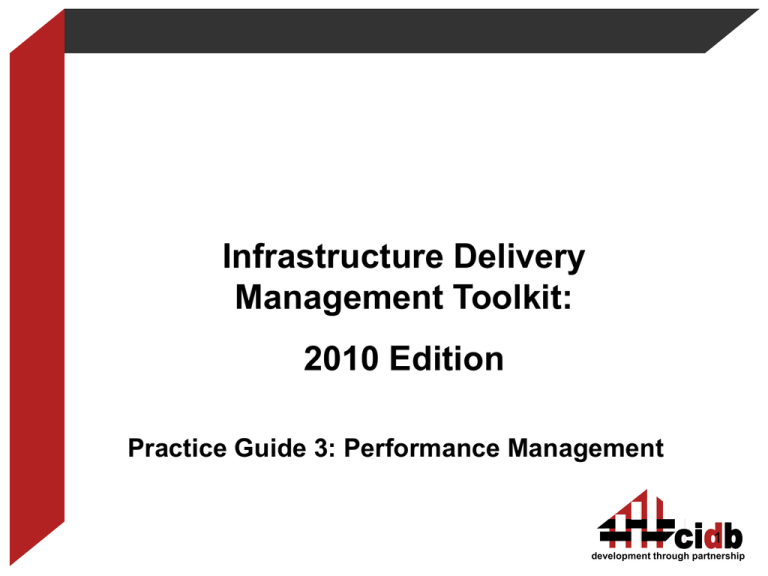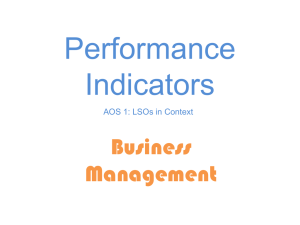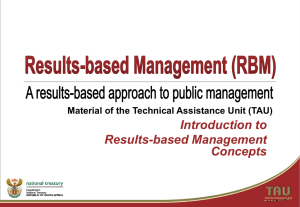20141202 - 7 PG3 Performance management (IDMS)
advertisement

Infrastructure Delivery Management Toolkit: 2010 Edition Practice Guide 3: Performance Management 1 cidb development through partnership Contents of this presentation • • • • The value of Performance Management The benefits of Performance Management The principles of Performance Management The practice of Performance Management 2 cidb development through partnership The value of performance management The value to the executive manager in using these performance management processes will: • Allow the department to function more effectively and efficiently • Free up executive time to focus on strategic issues to improve service delivery • Protect the executive from surprises when internal or external reports are published on perceived performance 3 The benefits of performance management Benefits to Senior Management – Structured focus of limited resources on strategic objectives – Effective efficient deployment of resources – Performance information for improved decision making – Decrease in wasted effort dealing with unintended consequences – Better performance of individuals and organisation – Accurate decision information to take management action 4 The benefits of performance management Benefits to Junior Management: • Structured, planned day to day work, with reduced ad-hoc detractions will allow the focus required to get the job at hand done well • Comfort that planned work is adequately resourced to be delivered on schedule • Ability to demonstrate a clear link between inputs, activities and outputs and the desired strategic objectives being served by such • Protection to junior and middle management by their ability to substantiate exactly how the lack of input resources (financial and human) will affect the achievement of high level objectives. • An objective and impartial structured performance management system that can measure the performance of infrastructure related work performance so that those well-performing managers can be rewarded for their good efforts. 5 Performance Management for Infrastructure Delivery Management THE PRINCIPLES 6 Agree desired Impacts Confirm achievement of Impacts Agree necessary Outcomes Monitor and Evaluate Outcomes Specify Outputs Monitor and Evaluate Outputs Compare actual against Planned Plan Activities Perform Activities Plan and Provide Inputs Deploy Inputs Outcomes Performance Management Approach Performance Management for Infrastructure Delivery Management THE PRACTICE 8 Controls •Policy •Strategy Performance Management Inputs • What do we want to achieve? •Plans •Budgets •Resource input; activities; outputs •Performance Data • How will we know when we have achieved it? • What are we going to do to achieve it? • Who of us are responsible for what? • How do we improve performance? Mechanisms •Performance management system A0 - Performance Management Outputs •Accountability •Improved Performance •What do we want to achieve? Controls •How will we know when we have achieved it? •Policy •Strategy •What are we going to do to achieve it? •Who of us are responsible for what? Inputs •Plans •Budgets 1 - Develop Performance Indicators •How do we improve performance? 3 - Publish Performance Information Inputs •Resource input; activities; outputs •Performance Data Outputs •Accountability 2 - Monitor & Evaluate Progr, Proj and Ops Performance 4 - Review & Appraise Performance of Individuals 5 - Take Management Action A1 - Performance Management Outputs •Improved Performance Develop Indicators from Strategic Plan Objectives Monitor & Evaluate Impacts against plan 1 Produce Outputs 1 2 Perform Activities Develop Indicators from Project / Operational Plans and budgets Monitor & Evaluate Outcomes against plan Monitor & Evaluate Inputs, Activities and Outputs against plan 2 Take Management Action Develop Indicators from Programme Plans and Budgets Publish Performance Information Measure against plan Deploy inputs Link Indicators and RACI to Individual Performance Agreements 2 1 1 3 Review / Appraise Individual Performance Numbers refer to Roadmap steps 4 5 Develop Indicators from Strategic Plan Objectives Measure 2 Plan Produce Outputs 1 Perform Activities Develop Indicators from Project / Operational Plans and budgets 2 Monitor & Evaluate Inputs, Activities and Outputs against plan 2 Take Management Action 1 Monitor & Evaluate Outcomes against plan Act Publish Performance Information Measure against plan Deploy inputs Link Indicators and RACI to Individual Performance Agreements 1 Develop Indicators from Programme Plans and Budgets Plan Monitor & Evaluate Impacts against plan Measure 1 Do 3 Review / Appraise Individual Performance Numbers refer to Roadmap steps 4 5 The Roadmaps and Steps •What do we want to achieve? Controls •How will we know when we have achieved it? •Policy •Strategy •What are we going to do to achieve it? •Who of us are responsible for what? Inputs •Plans •Budgets 1 - Develop Performance Indicators •How do we improve performance? 3 - Publish Performance Information Inputs •Resource input; activities; outputs •Performance Data Outputs •Accountability 2 - Monitor & Evaluate Progr, Proj and Ops Performance 4 - Review & Appraise Performance of Individuals 5 - Take Management Action Outputs •Improved Performance A1 - Performance Management 13 Roadmap 1 1. Agree on what you aim to achieve (Impacts and Outcomes) 2. Specify the Outputs, Activities and Inputs 3. Select Key Performance Indicators (KPIs) 4. Set realistic Performance Targets 5. Determine the process and format for Reporting performance A1.1 - Develop Performance Indicators 6. Establish Processes and Mechanisms to facilitate corrective action 14 Roadmap 2 1. Collect work performance data and produce performance measurements Monitoring involves collecting, analysing, and reporting data on inputs, activities, outputs, outcomes and impacts as well as external factors, in a way that supports effective management. Evaluation is a time-bound and periodic exercise that seeks to provide credible and useful information to answer specific questions to guide decision making by staff, managers and policy makers. 2. Collect budget forecasts 3. Evaluate performance of projects and programmes 4. Analyse and synthesize data into information A1.2 - Monitor & Evaluate Programme, Project and Operational Performance 5. Make performance information available to reporting systems and performance functions 15 Roadmap 3 1. Develop a reporting register 2. Develop report templates 3. Produce, publish and distribute reports 5.Confirm receipt and obtain feedback A1.3 - Publish Performance Information 16 Roadmap 4 1. Develop and maintain Master Responsibility Assignment Matrix 2. Provide Responsibility assignment information to HR 3. Provide Performance Information to HR function 4. Provide Management with performance management information A1.4 - Review & Appraise Performance of Individuals 17 Roadmap 5 1. Obtain and study performance related information and Critically reflect on root causes of good and bad performance 2. Extract and disseminate learning to improve performance 3. Take appropriate action to address causes of poor performance A1.5 - Take Management Action 18 1. Obtain and study performance related information and Critically reflect on root causes of good and bad performance 2. Extract and disseminate learning to improve performance 3. Take appropriate action to address causes of poor performance A1.5 - Take Management Action Performance management for infrastructure delivery EXAMPLE 20 The role of the RAM Programme Structure Corporate Structure 21 22 Earned Value Management EVM Indicators 23 Guidelines • 1) Policy Framework for the Government-wide Monitoring and Evaluation System; November 2007; The Presidency • 2) Framework for Managing Programme Performance Information; May 2007, National Treasury • 3) Improving Government Performance: our Approach; 2009, The Presidency • 4) The Standard for Program Management, Second Edition, published by the Project Management Institute. • 5)The Guide to the Project Management Body of Knowledge (PMBOK), Fourth Edition, published by the Project Management Institute • 6) Guide for the implementation of Provincial Quarterly Performance Reports - published by National Treasury 1 Apr 2009 • 7) Generic Monitoring & Reporting Guidelines for Infrastructure Projects (2006 toolkit 3S01) Conclusion and questions Thank you cidb 25










